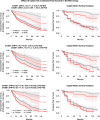Association of modifiable risk factors with progression to dementia in relation to amyloid and tau pathology
- PMID: 39462394
- PMCID: PMC11515263
- DOI: 10.1186/s13195-024-01602-9
Association of modifiable risk factors with progression to dementia in relation to amyloid and tau pathology
Abstract
Background: Dementia preventive interventions targeting multiple modifiable risk factors are a promising approach. However, the impact of modifiable risk factors in the presence of beta-amyloid or phosphorylated-tau (p-tau) pathology is unclear.
Methods: The objective of the study was to examine the role of modifiable risk factors (vascular factors, depression, and smoking) in the progression to mild cognitive impairment (MCI) or dementia among 434 cognitively unimpaired (CU) and 611 individuals with MCI from the Alzheimer's Disease Neuroimaging Initiative (ADNI) database. Vascular risk factors were summarized with the Cardiovascular Risk Factors, Aging, and Dementia (CAIDE) score, dichotomized into higher versus lower risk. Depression and smoking (yes/no) were categorised according to medical history or current symptoms. Analyses were stratified by beta-amyloid negative (A-) and positive (A +), p-tau negative (T-) and positive (T +), or beta-amyloid and p-tau negative (A-T-) and positive (A + T +) biomarker status. Cox proportional hazard models were adjusted for age, sex, education, baseline MMSE score, baseline hippocampal volume and ApoE4 carrier status.
Results: Higher CAIDE score was associated with increased risk of progression to all-cause dementia in most MCI subgroups: adjusted hazard ratios (aHR) [95% CI] were 3.1 [1.43; 6.53] in the A- subgroup, 1.7 [1.20-2.27] in T + , 2.6 [1.06-6.59] in A-T-, and 1.6 [1.15-2.22] in the A + T + subgroup. Smoking (yes/no) was associated with increased dementia aHR in the A + MCI subgroup: 1.6 [1.07-2.34]. Depression increased dementia aHR in the T + MCI subgroup: 1.5 [1.06-2.02]. No significant associations were found in the CU biomarker subgroups.
Conclusion: Addressing modifiable risk factors carries an important potential for reducing the risk of dementia even after the onset of Alzheimer's pathology. Knowledge of biomarker status can further optimize prevention strategies.
Keywords: Amyloid; CAIDE; Depression; MCI; Modifiable risk factors; Smoking; Tau.
© 2024. The Author(s).
Conflict of interest statement
The authors declare no competing interests.
Figures



References
-
- Risk Reduction of Cognitive Decline and Dementia: WHO Guidelines. Geneva: World Health Organization; 2019. Available from: https://www.ncbi.nlm.nih.gov/books/NBK542796/. - PubMed
-
- Kivipelto M, Mangialasche F, Ngandu T. Lifestyle interventions to prevent cognitive impairment, dementia and Alzheimer disease. Nat Rev Neurol. 2018;14(11):653–66. - PubMed
-
- Livingston G, Huntley J, Liu KY, Costafreda SG, Selbæk G, Alladi S, et al. Dementia prevention, intervention, and care: 2024 report of the lancet standing commission. Lancet. 2024;404(10452):572–628. - PubMed
MeSH terms
Substances
Grants and funding
- 138385/Hungarian Scientific Research Fund
- 138385/Hungarian Scientific Research Fund
- 138385/Hungarian Scientific Research Fund
- 138385/Hungarian Scientific Research Fund
- 138385/Hungarian Scientific Research Fund
- 138385/Hungarian Scientific Research Fund
- 138385/Hungarian Scientific Research Fund
- 138385/Hungarian Scientific Research Fund
- 2019-2.1.7-ERA-NET-2020-00006/EU Joint Programme - Neurodegenerative Disease Research
- 2019-2.1.7-ERA-NET-2020-00006/EU Joint Programme - Neurodegenerative Disease Research
- 2019-2.1.7-ERA-NET-2020-00006/EU Joint Programme - Neurodegenerative Disease Research
- 804371/ERC_/European Research Council/International
- 804371/ERC_/European Research Council/International
- 804371/ERC_/European Research Council/International
LinkOut - more resources
Full Text Sources
Medical

